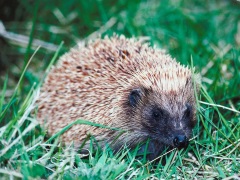Features
Bioenergy crops: problem or solution?
Date: 2018-12-14 15:48:49.0
Author: Jon Evans

A study by British and German scientists
predicts that the widespread growing of
bioenergy crops could lead to a 44% fall in
hedgehog numbers.
The debate over whether bioenergy crops are good or bad for the environment continues to rage, with two recent papers in the Proceedings of the National Academy of Sciences coming down heavily against them. One argues that bioenergy crops are not very effective at reducing global warming, while the other finds they could actually be just as bad for biodiversity as global warming.
The first paper is a comment piece written by two researchers with form in questioning the benefits of bioenergy crops. These are John DeCicco from the University of Michigan Energy Institute in Ann Arbor, US, and William Schlesinger from the Cary Institute of Ecosystem Studies in Millbrook, US. In 2016, DeCicco and colleagues calculated that only 37% of the carbon dioxide released by burning biofuels is taken up by the growth of new bioenergy crops, far lower than the 100% required for biofuels to be carbon neutral (see Challenging assumptions). In 2018, Schlesinger wrote an article for Science in which he highlighted the detrimental effect to wildlife of cutting down established hardwood forests as biofuel feedstocks (see Can’t see the wood for the trees).
The researchers repeat these points in their comment piece, arguing that the carbon debt built up by converting land to grow bioenergy crops and then burning those bioenergy crops won’t be paid back in the short term, or maybe at all. They therefore state that rather than growing bioenergy crops to replace fossil fuels, the focus should be on increasing the rate at which carbon dioxide is removed from the atmosphere by encouraging the growth of natural carbon sinks. In other words, we should be growing forests rather than bioenergy crops.
“High quality land is a limited resource,” says DeCicco. “For reducing atmospheric carbon dioxide, the most efficient use of ecologically productive land is to leave it alone, or reforest it. Let it act as a natural, long-term carbon sink." According to the two researchers, this could allow up to one-third of current carbon dioxide emissions from fossil fuels to be sequestered away.
The second paper reports a study that expands on one of these points, investigating in detail the effect on global biodiversity of the widespread growing of bioenergy crops. Conducted by a team of British and German scientists, the study involved modelling the impact on the global distribution of amphibians, birds and mammals of two future scenarios: a high-level and a low-level carbon dioxide emission scenario.
Under the high-level scenario, carbon dioxide emissions continue unabated, leading the average global temperature to rise by 3°C by 2100. Under the low-level scenario, measures are introduced to restrict carbon dioxide emissions, including growing bioenergy crops on 4.3% of global land area, limiting the rise in average global temperatures to just 1.5°C.
Global warming is already having a detrimental effect on biodiversity, via extinction and altered habitats, and these effects are predicted to get worse with further warming. But the study showed that the detrimental effect on biodiversity would actually be broadly the same under both scenarios, because the widespread growth of bioenergy crops would require the removal of lots of existing wildlife habitat.
"We found that the combination of climate change and large-scale expansion of bioenergy crops would together threaten about 36% of the habitats of all global vertebrate species, including many that are already the subject of significant conservation work,” said team member Stephen Willis from Durham University in the UK.
In the case of species with small geographic ranges, the widespread adoption of bioenergy crops actually had a greater impact than global warming. Animals that would be particularly affected included the hedgehog (44% potential loss in numbers), the red squirrel (46% potential loss) and the common starling (15% potential loss).
As a slight silver lining, another recent study by British scientists found that bioenergy crops could have a beneficial effect on invertebrate pollinators such as bumblebees, butterflies and hoverflies. Even here, though, the precise effect depended on the specific crop and insect. In a paper in GCB Bioenergy, the scientists report that the activity of bumblebees, butterflies and hoverflies all increased on wildflowers growing next to a field of willow trees, compared with a field of cereals. But only the activity of butterflies increased on wildflowers growing next to a field of miscanthus grass.
The views represented here are solely those of the author and do not necessarily represent those of John Wiley and Sons, Ltd. or of the SCI.
Displaying 2 keywords used to tag this article:
- Jules Audemars-Australia Best Quali
- DG6582 Mens Moncler Down Jackets Gr
